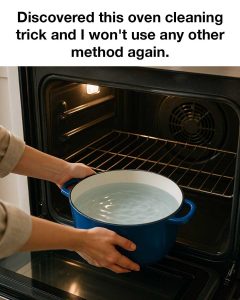Cleaning the oven is one of those chores that most people dread. The buildup of grease, burnt-on food, and stubborn residue often turns this task into a time-consuming ordeal. What’s worse, many of the traditional cleaning methods involve strong chemical agents that smell terrible, are rough on your hands, and may even be harmful to your health and the environment. Fortunately, there’s a much better way to handle this job—one that’s easy, safe, and surprisingly effective. It’s called steam cleaning, and once you try it, you might never go back to scrubbing with store-bought oven cleaners again.

I stumbled upon steam cleaning while searching for natural, eco-friendly ways to clean appliances in my home. I wasn’t specifically looking for an oven solution, but this method caught my attention because it didn’t require any fancy gadgets or strong chemicals—just water and vinegar. Curious, I decided to try it on my oven, which was long overdue for a deep clean. I filled a heatproof bowl with water and added a few tablespoons of vinegar, then set it on the middle rack of my oven. I turned the temperature up to 250°F and let it sit for 30 minutes. The steam began to build and fill the oven, softening the baked-on grime. When it cooled down, I wiped the inside with a damp cloth. To my surprise, the grease came off with almost no effort. There was no scrubbing involved, no toxic fumes—just a clean oven and a feeling of accomplishment.
What makes steam cleaning so effective is the science behind it. When water is heated, it turns into steam, which has the ability to loosen dirt, grease, and food particles by breaking down their structure. Adding vinegar enhances this effect because vinegar contains acetic acid, which cuts through grime and mineral deposits. The steam not only breaks down the mess but also reaches into tight corners and crevices where traditional tools and sprays often fail. And because it uses high heat, it naturally sanitizes surfaces, killing bacteria and germs in the process. That means you get a deep clean without exposing your kitchen to harmful substances.
Here’s how you can do it step-by-step: Start by removing any large crumbs or loose debris from your oven. Then, take a heat-safe bowl and pour in about a cup of water. Add two to three tablespoons of white vinegar. Place the bowl in the middle of your oven and set the temperature to 250°F. Let it run for about 30 minutes. During this time, the steam will circulate and soften all the grime stuck on the walls, racks, and base of the oven. After the oven cools down enough to touch, take a soft damp cloth or sponge and simply wipe away the loosened residue. If you have a few particularly stubborn spots, make a paste using baking soda and water, apply it to the area, wait a few minutes, then wipe it clean.
One of the biggest benefits of steam cleaning is its environmental friendliness. Traditional oven cleaners contain harsh ingredients and volatile organic compounds (VOCs) that contribute to indoor air pollution and are risky to breathe in. These chemicals can linger in your oven, and there’s always a worry they might contaminate your food. With steam cleaning, you’re only using water and vinegar—both natural and safe ingredients. This not only keeps your kitchen healthier but also reduces your ecological footprint.
Steam cleaning also saves you time. The entire process, from setup to wiping down the oven, takes about an hour—and most of that time is hands-free. You’re not kneeling on the floor, scrubbing with sponges, or inhaling chemical fumes. The oven does most of the work while you do something else. For busy people, this method is a huge win. It’s also a fantastic option for anyone who wants a hassle-free way to stay on top of kitchen cleanliness without spending an entire afternoon doing it.
Another great advantage? Steam cleaning is gentle on your appliance. Harsh chemicals and abrasive scrubbing tools can damage the interior of your oven over time. Protective coatings can wear down, and scratches can accumulate, shortening your oven’s lifespan. But steam is soft. It cleans without scratching or wearing out surfaces, making it ideal for keeping your oven in great shape for the long haul.
Safety is also a top concern when cleaning any surface that comes into contact with food. Chemical residue left behind by commercial cleaners can pose a serious health risk if not properly rinsed. Steam cleaning eliminates this risk completely. With no chemicals involved, there’s nothing left behind that can harm you or your family. You can cook your next meal right after cleaning with full confidence that your oven is safe and sanitary.
When compared side by side with traditional cleaning methods, steam cleaning clearly stands out. Most commercial cleaners require multiple steps, from spraying and waiting to scrubbing and rinsing. They often call for gloves, ventilation, and a serious time commitment. Steam cleaning is simple. Just one bowl, one temperature setting, and one cloth to wipe it all clean. Plus, it’s cheaper, safer, and better for the planet.
Regularly using the steam method also helps your oven perform better. A clean oven heats more evenly, operates more efficiently, and is less likely to develop odors or smoke. Grease buildup can cause hotspots or reduce airflow inside your appliance. Steam cleaning prevents all of this, helping your oven stay reliable and look newer for longer.
In an age where online cleaning hacks go viral every week, steam cleaning is one of the few that truly lives up to the hype. It’s not a gimmick. It’s not just for show. It actually works, and it works well. It has been tested and approved by countless home cooks and busy homeowners looking for a better solution. Real people are seeing real results. One woman shared that her oven looked brand new after one steam clean, even though she hadn’t cleaned it in months. Another said she was able to clean while cooking dinner—talk about multitasking.
If you’re tired of dreading oven cleaning day, consider giving steam cleaning a try. It’s simple, safe, affordable, and incredibly effective. You don’t need any fancy products or professional services—just a little water, some vinegar, and a bit of time. Once you see the results, you’ll wonder why you didn’t make the switch sooner.





